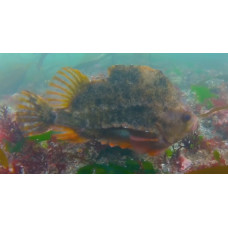Latin name
Cyclopterus lumpus
Other name
Lumpfish, Hen-fish, Kiark-varrey.
Identification
The body of the Lumpsucker is large, thick, and compressed at the sides. There are bony tubercles on the sides of the body and on the back. The head and pectoral fins of males are larger than those of females. There is a thick layer of jelly-like fat under the skin. Vertebrae: 28-29. Gill openings are large and extend below the level of the ray of the upper pectoral fin. The pyloric portion is present at 36-79 cm.
Features of fish fins
Dorsal spines (total): 5 - 9; Dorsal soft rays (total): 9 - 11; Anal spines: 0; Anal soft rays: 9 - 10.
The pelvic fins of these fish form a suction cup for attaching to rocks, algae and other objects. The first dorsal fin is present, but is covered with a thick layer of skin that forms a characteristic high ridge with embedded spines.
Fish colouring
The body coloration of adult females is gray, sometimes with a blue or green tinge, the belly is lighter or white. Males are usually darker: from greenish-olive to blackish-gray on the back with dark spots on the sides, the belly is slightly lighter. During spawning, males change coloration: belly, sucker and fins are bright orange-red, body becomes grayish with silver spots on the sides, back becomes almost black.
Distribution
Lumpsucker is found in the Western Atlantic: from Nunavut, Hudson Bay to James Bay and Labrador in Canada to New Jersey in the USA; less commonly to Chesapeake Bay in the USA and Bermuda. Eastern Atlantic: from the Barents Sea, Iceland and Greenland to Spain.
Habitat
A marine, polar, oceanodromous species. Depth range 0-868 m, typically 50-150 m. A number of aspects of its biology (absence of swim bladder, abdominal sucker) suggest a bottom dwelling lifestyle, with fish caught equally often in pelagic nets and bottom trawls. These fish spend most of the day on the bottom, only occasionally ascending to the middle layers of the ocean. Closer to spawning, however, fish leave the bottom more often and spend more time swimming in the water column. The lack of a swim bladder allows the fish to make rapid movements from the surface to the bottom during the day. The Lumpsucker is therefore considered a semi-pelagic/semi-bottom fish.
Size
Males typically reach a length of 30-40 cm, while females are larger and can reach 50 cm and a mass of 5 kg. The maximum recorded length is 61 cm and mass is 9.5 kg. In the brackish waters of the Baltic Sea, they do not exceed 20 cm in length. Maximum recorded age: 13 years.
Behavior
They are usually solitary rather than gregarious fish. They have a homing instinct. Adults inhabit rocky bottoms, but can also be found among floating algae. During their annual cycle, they migrate considerable distances between deeper waters in winter and shallower waters in summer. After hatching from eggs, juveniles spend several days in tidepools or attached to floating algae by suction cups. As the juveniles grow, they move to the open sea. They can be found among algae beds in bays and fjords, moving away from the shore as they mature.
Food and feeding habits
Adults feed on scallops, jellyfish, small crustaceans, polychaetes, jellyfish. Juveniles feed on gelatinous zooplankton, eggs of other fish and small crustaceans.
Reproduction
These fish become sexually mature in the 3-4th year. Spawning takes place in the coastal zone from February to July, depending on the region. Eggs are laid in large quantities on the rocky bottom. The males guard the eggs, which can be 80-136 thousand pieces, they are laid in the surf zone and during low tide they remain drained for some time.
Fishing
It is a valuable commercial fish. The main countries that catch this fish are Denmark (in Greenland) and Iceland. Denmark and Sweden also catch this fish, but their catches are small compared to other countries. The fish is caught with gill nets.
Relationship with a person
Harmless. Females are caught mainly for their eggs. The caviar itself is pink in color, but it is often tinted red or black and then resembles the caviar of salmon or sturgeon fish. Their caviar is rich in proteins and vitamins. Liver and flesh are also eaten. It is often used in oriental cuisine.
Interesting facts
When it is time to spawn, the female lumpsucker lays a mass of eggs on rocks in the coastal zone. After finishing spawning, she swims away into the ocean depths—the future fate of her offspring does not concern her. As soon as the carefree mother departs, the male stands guard. He carefully protects the eggs, clinging to the rocks in the surf with a special suction disc. During low tide, when the eggs are suddenly left stranded, the lumpsucker fills its stomach with water and swells up like a ball to become heavier and stay in the surf zone. During low tide, he continually sprays the eggs with water. This continues until the fry hatch from the eggs. They stay in a school near their father. At the first sign of danger, the little fish rush to their father and attach themselves to him by suction.
| Classification | |
| Phylum | Chordata |
| Class | Actinopterygii |
| Squad | Perciformes |
| Family | Cyclopteridae |
| Genus | Cyclopterus |
| Species | C. lumpus |
| Features | |
| Conservation status | Near Threatened |
| Habitat | Pelagic |
| Life span, years | 13 |
| Maximum body weight, kg | 9,5 |
| Maximum length, cm | 61 |
| Sailing speed, m/s | No information |
| Threat to people | Edible |
| Way of eating | Planktonophage |
Lumpsucker
Tags: lumpsucker





